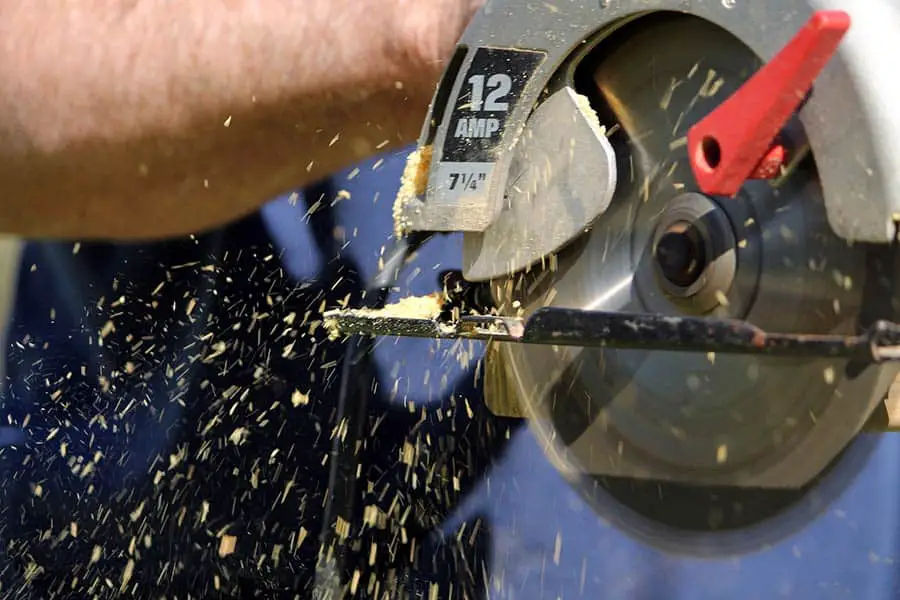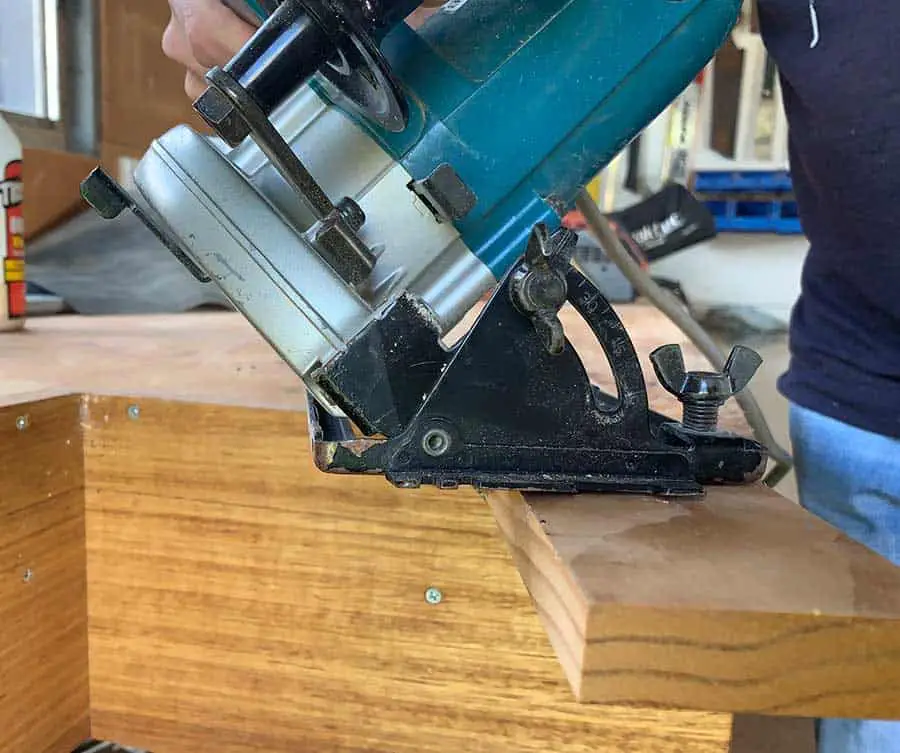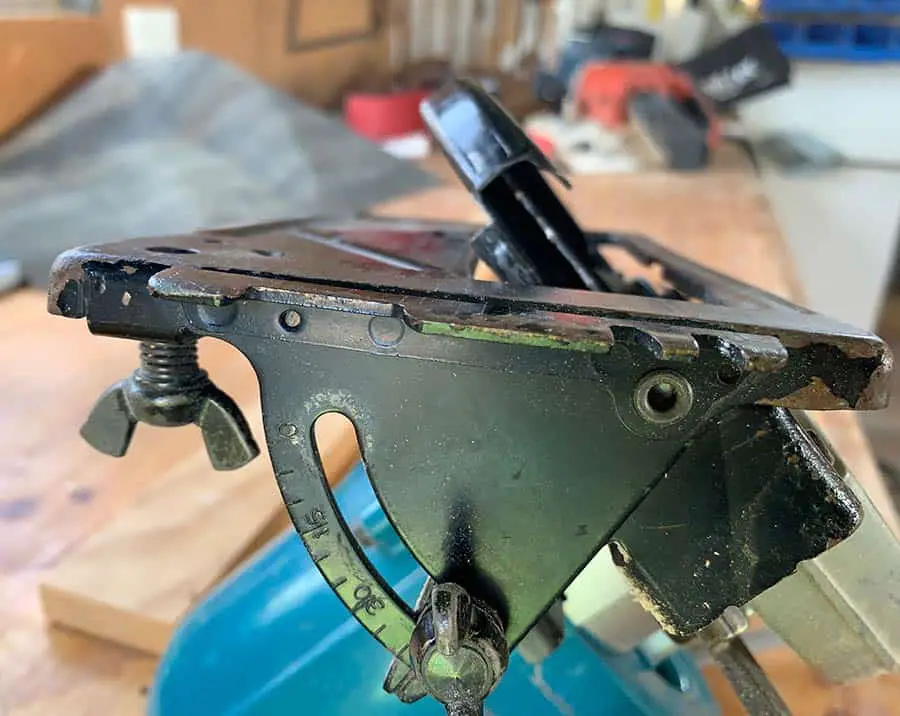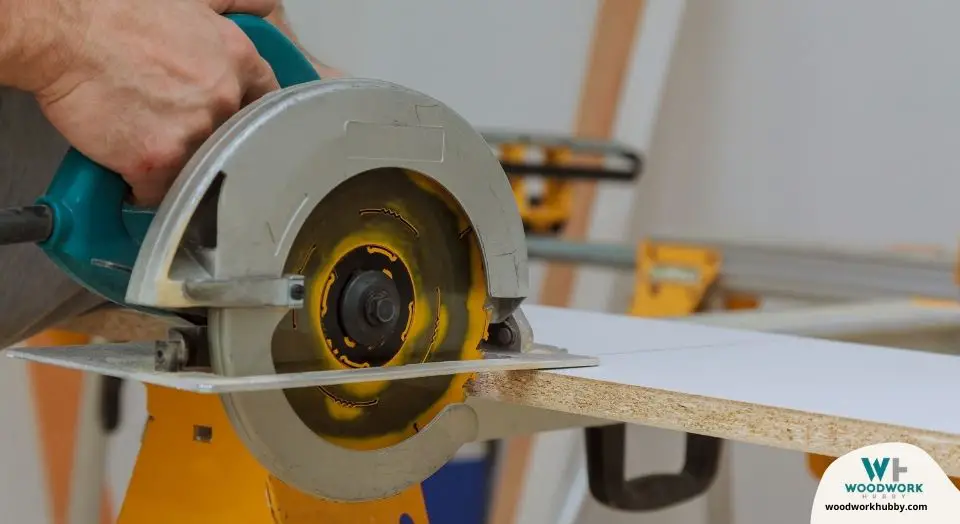I have seen it many times before. You are part way through your woodworking project and now you have to cut an angle on the piece of stock. Out of all the tools you have, you grab a circular saw while thinking it will be the best option. But can a circular saw cut angles?
Yes, a circular saw will easily make angled cuts by tilting the base to the desired angle from 0 to 45 degrees. These are called beveled cuts. These cuts can be made much more accurately by the help of a clamped straight edge to prevent the saw from moving during the cut.
In this post, I will explain more about how to use a circular saw to cut angles for your woodworking project as well as what you can expect when you do. By the time you’re done reading, you’ll feel better prepared to cut angles into your woodworking projects successfully.
Are angled cuts from a circular saw accurate?

Generally, the circular saw is the go-to tool for all cutting needs in the woodshop although is it the most accurate? As I explained earlier, it is very easy for the saw to wonder while you are cutting especially when you have the blade tilted over on an angle.
I highly suggest using a straight edge that you clamp down to the workpiece. I then run my base plate on the saw along this straight edge which gives you a much nicer finish and cleaner cut.
Can I use my circular saw to cut angles on narrow pieces of wood?

This is where a circular saw may not be the best tool for the job. While it is ok to use on long angled cuts especially on sheet material, cutting an angle on a narrow piece of wood (let’s say around 2 inches wide) does become more dangerous and less accurate.
This is because it is difficult to balance the saw on narrow stock and most of the time you cannot see your pencil line to follow. Doing this type of cut does become dangerous and this is why I would recommend some other saws below.
What Kind of Saw Should You Use to Cut Angles?
Throughout the rest of this article, I’ll discuss the various angled cuts you can achieve with a circular saw. Do keep in mind though that this isn’t the intended purpose of this type of saw.
A circular saw is named such because it rotates on an arbor to make the cut. This power saw may have an abrasive blade or disc as well as teeth to make these smooth cuts possible. Besides their use in woodworking, circular saws are also favored in industries that cut metal, plastic, and/or masonry.
Like I said in the intro, if all you have for cutting angles into wood is a handheld circular saw, that should suffice. I will talk more about the ways how in the next sections. For now, let’s answer another question. That is, what kind of saw is recommended for cutting angles?
That would be the miter saw, which is sometimes also referred to as a compound saw or power miter saw. You choose the angle for your crosscut with a miter saw and then get to slicing. If you’re working on a project for household trim or molding, a miter saw is the best choice because it will cut wood at the precise angles you need it.
These types of saws do a much better job of cutting very accurate angles on the ends of the wood. The cuts are much cleaner than what you can get from a circular saw also.
In saying this, not all miter saws are necessarily the same. Here are the various types I use daily:
Standard/Power Miter Saws
The powered standard miter saw can slice wood at the angle you choose, but this saw is especially adept at cutting perfectly straight 45-degree angles into wood that comes in handy when framing.
LED/Laser Miter Saws
If you need a bit of extra help with your precision and accuracy, the LED or laser miter saw will become your best friend. The included laser guide has a washer connected to the saw blade that ensures your lines are always straight. The LED lighting also makes it easier to see, which is helpful.
Compound Miter Saws
A compound miter saw has a tilting blade. When combined with the saw head, which you can set at an assortment of angles, you can easily make bevel cuts with a compound miter saw. These are the saws I highly recommend using when wanting to make angled cuts.
Sliding Compound Miter Saws
The sliding compound miter saw features a moveable saw head attached to a sliding rail. You can now cut wider pieces of wood with this saw. The rails lock in place as well for working on a particular corner or edge of the wood. Spending a little extra money on these saws is best as you get a much more accurate cut while the saw is sliding.
Dual Compound Miter Saws
Another type of compound saw is the dual compound miter. Also known as a double miter saw, the head of this miter saw can switch from right and left as well as rotate for cutting every angle imaginable.
How Do You Cut a 45-Degree Angle with a Circular Saw?

Don’t sleep on a circular saw though. It’s not the easiest saw to use when you wish to cut angles, but its wide range of cuts makes it a suitable choice to have in your workshop.
Okay, so let’s say you wanted an angle for your woodworking project that’s exactly 45 degrees. Here are the steps to follow to get that cut with a circular saw.
- Step 1: Set Your Circular Saw’s Depth of Cut
If you haven’t plugged in your circular saw yet, then don’t do it. If you already did plug it in, unplug it, as you need to select the depth of the cut.
Pull the blade guard back and adjust the depth the blade protrudes from the base. The saw blade should always protrude through the wood until the gullets of the teeth are visible.
Before you move on, make sure the depth-adjusting lever is as tight as possible.
- Step 2: Align Your Circular Saw Blade with Your Mark
Make a mark on the wood where you want to cut the 45-degree angle. You might have to keep your hand on the wood so it doesn’t shift, so make sure you’re wearing gloves when you work. Attaching a clamp to a square would be highly beneficial also as you can then ensure your cut is straight and square.
Check that the circular saw’s blade is aligned with the mark you make by nicking your wood board ever so slightly. If things aren’t aligned, change the positioning until you have the alignment you need.
- Step 3: Rely on a Guide for Straight, Accurate Cuts
As I mentioned earlier in this article, A guide will help you get those smooth, beveled cuts you want with your circular saw, so use a level or similar guide. One that has adjustable features is best so the guide is useful for a multitude of projects.
How Do You Cut a 2×4 Angle with a Circular Saw?
Let’s say that you want to cut an angle into a piece of 2×4 wood. How would you go about doing that? The instructions aren’t all that different than what I covered above, but I will still go over everything anyway for your benefit.
- Step 1: Select Your Circular Saw’s Blade Depth
To get the cut depth correct for your 2×4 woodworking project, you need to first establish what the blade depth will be for your circular saw. Setting the blade depth too deep may cause the circular saw to kick back in your project during the cut.
Once again then, unplug the circular saw if it isn’t already, and then adjust your saw blade guard, pulling it into place. Hold the blade guard against your piece of 2×4 wood so the circular saw’s blade is under the wood base roughly a quarter of an inch to half an inch.
- Step 2: Add your Hold-Down Clamp
To keep everything in place when you’re using your circular saw, you’ll need a hold-down clamp. For this project, only one clamp is required. Attaching a hold-down clamp to both sides of the 2×4 can lead to one clamp slipping down.
This will make your circular saw unable to complete the cut, as it has resistance when it slices into the 2×4.
You could lose control of your circular saw in such a scenario, which could lead to serious injury and, in some cases, even death. Just stick to a single hold-down clamp. Putting your piece of wood on your sawhorse should set the 2×4 up in the perfect position for you to cut it.
- Step 3: Mark the 2×4 and Cut
With a guide or scale, determine where you want your angled cuts to go. Then make a mark with a pencil. Cutting as close to that mark with your circular saw will allow you to slice precise angles into your 2×4.
Step 4: Clamp on a straight edge guide or square.
This will ensure your cut is neat and square
Are There Any Downsides to Using a Circular Saw to Cut Angles?
As the above two tutorials have shown, a circular saw is a suitable choice for cutting angles into the wood. It really does depend on what type of angle you want to cut and how big your piece of timber is.
Just keep in mind the following factors before you choose your saw so you’re happy with your woodworking project when it’s done.
Cuts are generally rougher
Because your hand is guiding the saw through the wood, any small movements you make will definitely show in the final cut. This is why a straight edge is so important if you would like a nicer finish.

In saying this, if you want an extremely neat and accurate cut, I would always opt for a compound miter saw. These are the ones I would consider for your workshop.
Base Plate Tilting Can Cause Blade Catching
You also have to watch where you tilt your base plate. If it’s too far in one direction, then your circular saw’s lower blade may get stuck at the edge of your wood. Pressing harder into the wood with your saw will only make it worse.
Instead, you want to press the release trigger, lift up your blade guard, and then cut. Let the circular saw blade get an inch into your board and then move the guard.
Important safety tips
I always wish each of you enjoy your time in the workshop and for this to happen, you need to be safe at all times.
When using your circular saw, the most important safety tip I can give is always stand to the side of the saw when cutting and never directly behind it.
The reason for this is if the saw binds in the wood it has a tendency to kick back towards you. By standing to the side, you can eliminate any possible damage to yourself if the saw does kick backward.
As per usual, always wear appropriate glasses and hearing protection.
Conclusion
In a pinch, a circular saw can replace a miter saw for cutting angles in 2x4s and other pieces of wood. The angle has to be no greater than 45 degrees, and you should expect your project to have a rougher finish on the cut.
Now that you know more ways to use your circular saw, you’ll appreciate this woodworking instrument all the more!




